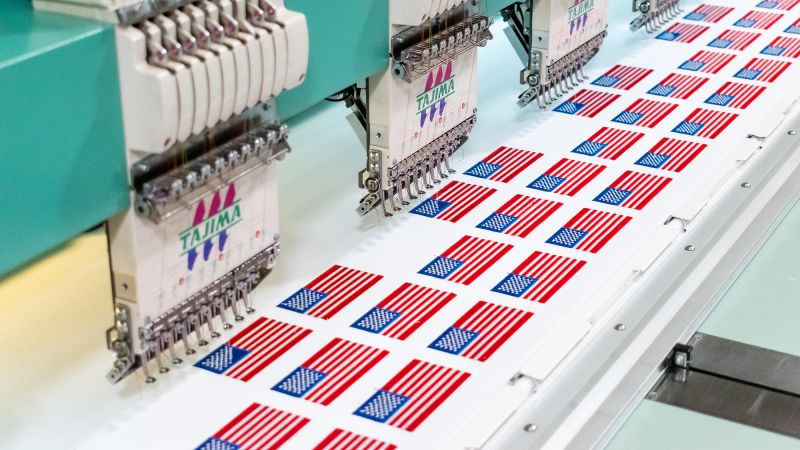In early February, Randy Carr, the CEO of World Emblem, made a pivotal decision by booking a flight to the Caribbean. This action was stimulated by a recent announcement from then-President Donald Trump, who had unveiled a 25% tariff on goods imported from Mexico and Canada. This move indicated the beginning of an extensive wave of tariffs aimed at various foreign nations. World Emblem, recognized as the world’s largest supplier of clothing patches, counts major entities such as the Department of Homeland Security, UPS, NHL, and Levi’s among its clientele. Notably, the company manufactures approximately 65% of its patches in Aguascalientes, Mexico.
Reflecting on the sudden imposition of tariffs, Carr expressed his shock, stating that the announcement arrived more abruptly and with greater intensity than he had anticipated. The steep 25% tariffs were alarming enough for him to declare that immediate action was necessary to adapt to the evolving trade landscape. Though President Trump eventually retracted the blanket tariff to target only those goods that violated the U.S.-Mexico-Canada Agreement (USMCA), the underlying uncertainty surrounding such trade policies prompted World Emblem to reconsider its supply chain strategy.
The urgency to diversify manufacturing locations swiftly escalated the pace of operations within the company. Carr recounted how, only a week later, they found themselves on a flight to the Dominican Republic. As part of a broader trend, World Emblem, along with numerous American corporations, was seeking to relocate production away from nations burdened with high tariffs such as Mexico and China. The company also faced a 30% tariff on approximately 30% of its products manufactured in China, reinforcing the need for strategic relocation.
The Dominican Republic has experienced significant growth in its manufacturing sector in recent years, attracting nearly 20% of foreign investment, only slightly trailing tourism, according to the Innovation Technology and Information Foundation. Moreover, data from the United Nations Conference on Trade and Development reveal a 7.1% rise in foreign direct investment (FDI) in the Dominican Republic last year. The region now accounts for an impressive 41% of total FDI flowing into Central America.
Several key factors contribute to the Dominican Republic’s appeal as a manufacturing hub. The country boasts a stable government, a proficient workforce, and strategic geographical proximity to the United States. Particularly significant are the so-called “free zones,” where about 60% of the country’s manufacturing occurs. These zones, which operate with minimal tax obligations, represent substantial financial savings for businesses.
Marino Auffant, founder of Auffant Global Advisory, emphasizes that while the Dominican Republic is celebrated for its picturesque beaches, its manufacturing capabilities often remain lesser-known. Over the past few months, there has been a noticeable trend of American companies, particularly those withdrawing from China, announcing operations in the Dominican Republic. Prominent brands such as Hanes, Timberland, and various aerospace and medical device manufacturers have established facilities in the region.
For World Emblem, the decision to invest in the Dominican Republic is projected to save the company significant financial resources annually. The firm intends to break ground on a new 100,000-square-foot manufacturing facility, slated to open next year. Ultimately, the objective is for the company to relocate 30-35% of its production capacity to the island, signaling a swift response from Carr’s team amid the ever-shifting trade dynamics.
One critical aspect driving this manufacturing shift is the existence of 92 free zones (FZs) in the Dominican Republic, housing over 850 companies as reported by the National Free Zone Council. These zones, operational for nearly five decades, provide substantial tax incentives. While they are not completely exempt from tariffs, they offer relief from a variety of tax obligations.
The dynamics of shipping and logistics further enhance the Dominican Republic’s attractiveness as a manufacturing destination. With only three days needed for a cargo vessel to reach Miami and five days for New York, the logistics are significantly more efficient compared to the three to six weeks required from Asian ports. These timeframes position the Dominican Republic favorably for companies focused on exporting to North America.
Despite these advantages, challenges remain for manufacturers looking to base operations in the Dominican Republic. Land availability is limited due to the country’s small geographic size. This has posed an ongoing hurdle for the government in securing adequate space for free zones. Additionally, there is a need to expand the local workforce, particularly at the engineering level, to support the burgeoning manufacturing sector.
A significant barrier to growth is a general lack of awareness regarding the Dominican Republic’s manufacturing capabilities. Many companies default to other production locations simply due to insufficient knowledge about the country’s potential. In an unexpected twist, Carr identified ChatGPT as a helpful resource in discovering the Dominican Republic as a viable option for manufacturing, highlighting the evolving role of technology in business decision-making.



